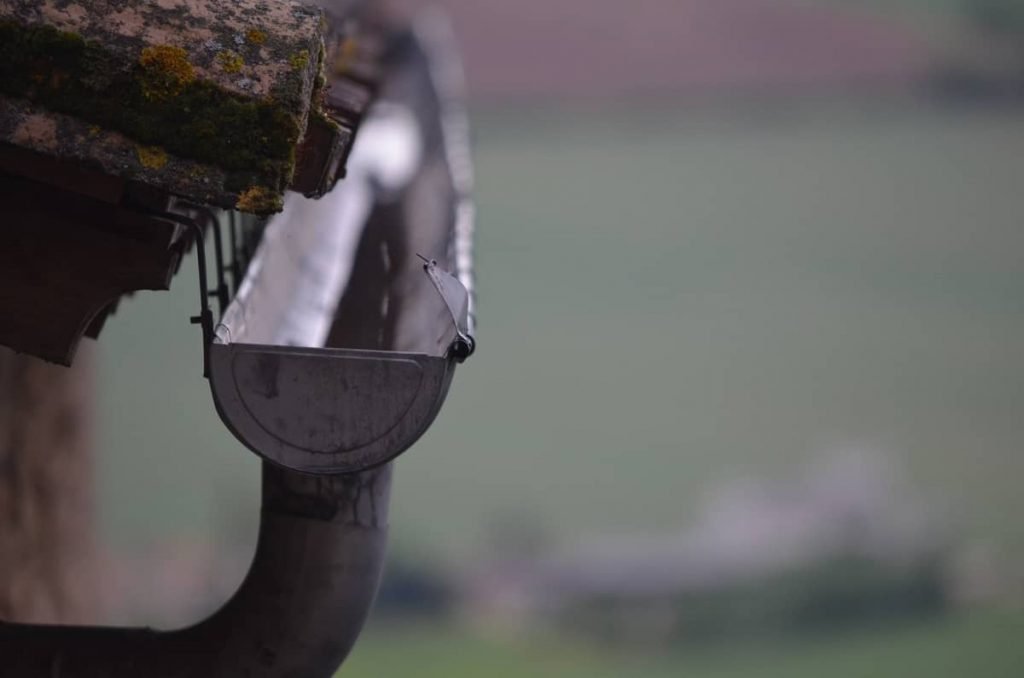Gutter cleaning might not make it to the show Dirty Jobs. But as far as household chores go, it’s up there. However, clean gutters are necessary to keep water from seeping into your roof and walls. Lots of gunk can build up during the year, so be sure to stay on top of the task!
What Can Go Wrong If Your Gutters Clog Up
The job of your gutters is to lead water away from your house. Without them, rain and melting snow would drip down around your foundation. And that water can damage the structure and leak into your home.
Clogged gutters are as bad as – or worse than – no gutters at all. When leaves or ice keep water from flowing freely, that water will find a path. And that path may be through your walls!
Of course, clogged gutters also mean they weigh more than they are supposed to. That can lead to them bending or pulling away from the house.
It’s best to clean the gutters twice a year. The best times are the spring and late fall, once most of the leaves are off the trees.
Safety First
As with any backyard chore, safety always comes first. That’s particularly true with gutter cleaning! This task requires working from a ladder or from the roof itself.
If you don’t feel comfortable with that, you should get a contractor to do the work for you.
Be sure to observe all the rules of ladder safety. Yes, cleaning out your gutters is essential. But risking injury isn’t worth it.
Tools You’ll Need
Before going through the process, let’s look at the equipment you’ll need to clean your gutters.
- Ladder
- Trowel
- There are scoops designed for gutters, but a trowel works just as well. Even a kitchen spatula can do the job. You could even use a toy beach shovel – but be careful not to break it!
- Tarp – this is going to make the final cleanup so much easier!
- If you don’t want to use a tarp, you may want to take a bucket up the ladder with you.
- Hose
- Gloves
- Long pants, a long-sleeved shirt, and a hat or cap are ideal.
At the end of the article, we’ll look briefly at some other ways to clean your gutter. They each require different tools. But for now, let’s consider the most common way to maintain your gutters!
Keep Your Cleanup Simple
You may be asking yourself why we included a tarp among the supplies you’ll need. After all, you’ll be working in a narrow channel high above the ground.
You’ll be glad, though, if you put that tarp on the ground under the stretch of gutter you’re cleaning. You’ll be dropping leaves, twigs, and gunk of all sorts. It’s so much easier to pick up when it falls on a tarp!
When you move your ladder, remember to move the tarp, too. It’s a simple way to save you extra work later on.
Get Rid Of The Gunk
For the first part of the job, you need to take your trowel up the ladder with you.
This part may not be so bad if you’ve kept on top of the job. But even if you do this chore twice a year, there can still be a rapid buildup of junk.
We always find it amazing how much dirt accumulates! Yes, dirt. A lot of it comes from dust that washes off the roof. And some is probably from decomposing leaves.
Use your trowel (or another tool) to dig out the waste. Sometimes it might be easier to use your hand.
You’re going to get dirty, and you’ll probably get wet, too. That’s why we recommend gloves, long sleeves and long pants. There may also be sharp metal edges in the gutter, so the gloves can help protect you.

Check For Issues
While you’re cleaning, take a good look at the condition of the gutter. Make sure it’s firmly attached to the edge of the roof. Look for any spots where it may be pulling away. Also, be alert for any edges that are bent.
Other problems include places where joints have started to separate or places where hangers are sagging.
You may be able to fix some issues yourself by caulking seams or replacing damaged hinges. Bigger jobs usually require professionals.
Rinse Away The Leftovers
Before this next step, you may want to put a bucket at the bottom of your downspout to catch any debris that comes shooting out! There could be a lot, so the extra step is worth it.
You will need the hose after you remove the debris from the channel. If your system has only one downspout, use the hose at the far end of the gutter. If there are multiple downspouts, use the hose about halfway between them.
Use the water from the hose to wash the gutter out. Allow it to run for a while. It should immediately flow down the downspouts.
If the water backs up, there is likely a clog in your downspout. You can use a power washer or drain snake to unclog it.
Water should flow toward the downspout. If a puddle forms anywhere along the gutter, you have a low spot. You’ll have to fix this so that the water flows correctly. Remember that standing water can become a breeding ground for mosquitoes and other insects. In winter, these low spots can become a problem area for ice dams.
Snow on the roof isn’t really part of cleaning the gutters. However, if it slides off, it can bring down the gutters with it. It might be worth considering snow guards on the roof to help prevent this.
Do You Have Gutter Guards?
If you don’t already have gutter guards installed, we highly recommend them! These screens lay atop the gutter. They let water in but keep most leaves, twigs, and trash out.
Sure, smaller particles will pass through since the mesh is large. But gutter guards keep the bulk of this material out.
You should still clean the gutters twice a year, but the guards will prevent blockages and simplify the cleaning process.
Some Alternative Ways To Clean The Gutters
We like the method for gutter cleaning we’ve described, even though it requires a bit of dirty work. But you could try out some other ideas.
Our biggest problem with these is that you have to carry a heavy tool up the ladder with you. We prefer to avoid that hassle. But if you can handle it, great!
A wet-dry vacuum is one alternative. It will suck up the debris, including any standing water. And all the junk ends up in the canister, ready to be dumped in the trash.
Another option could be a leaf blower. It only works well if all the trapped debris is dry, though. But there are usually damp leaves trapped at the bottom of the gutter.
A power washer is probably your best option. It provides the force you need to remove all the debris. The biggest drawback, though, is that it can flush that debris into the downspout. And sometimes, it’s more difficult to remove from there.
Conclusion
Cleaning the gutters is messy work. But it’s a necessity to help keep your house in good shape. Gutters protect your foundation. But if they’re clogged, they can damage your roof and walls. Every spring and fall, be sure to look after them!









